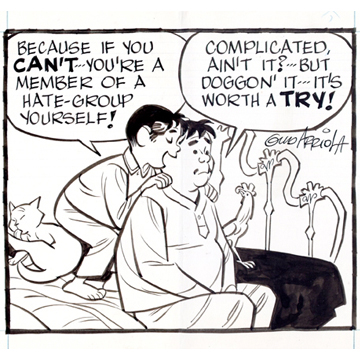Ishii, Arriola, and stereotypes
The MoMA just posted a comics biography of Ruth Asawa done by Jillian Tamaki. On the second page, Tamaki mentions Chris Ishii and a comic strip created about life at the Japanese-American concentration camps. I had never heard about this strip before. As someone who is interested in and taught Citizen 13660, I wanted to learn more.
The strip created by Chris Ishii was called “Lil’ Neebo” and it appeared in the Granada Pioneer, the newspaper out of Camp Amache. The character of Neebo was supposed to represent a Nisei boy and his experiences in the camp. Yet, the appearance of Lil’ Neebo relies on the Asian racial stereotypes that were prevalent at the time: slanted eyes and buck teeth (the best site I found with images of the strip is Cartoon Brew). It’s the same kind of face that you see other comics characters of the time period punching.
Ishii himself had been working for Disney when the war broke out. As is well discussed and documented, Disney often relied heavily on racial stereotypes in its works. So much so that today may of their older movies come with a warning label that starts with the line “this program includes negative depictions and/or mistreatment of people or cultures.” So while Ishii was incarcerated due to his Japanese ancestry, the culture he learned to draw in taught him how to depict that ancestry.
This is very similar to the story of Gus Arriola. Arriola’s parents were from Mexico and he grew up in, what he called, “the northern part of Mexico ‘now known as Arizona'” (Harvey 9). Arriola ended up working for an L.A. animation studio also, the Disney competitor Mintz. From there he moved to the animation department at MGM. This was during the 1930s, a tad earlier but basically the same era that Ishii worked in. And Arriola also started a comic strip, Gordo.
Gordo was the first U.S. comic strip to be set in Mexico. Yet the early strips relied heavily on stereotypes. Gordo himself was a lazy bean farmer who often wore a sombrero and spoke in a heavily accented English even though he was in Mexico and so presumably must have been speaking Spanish.
So here we have two artists, both trained in the L.A. animation culture of the 1930s and 40s, and who both absorbed and recreated the racial stereotypes used to represent the people of their own backgrounds.
To Arriola’s credit, he realized this. Later in his career, he acknowledged his use of stereotypes and that he had been trained to use them (Harvey 32 and 35). Arriola dropped the dialect in the strip and Gordo stopped being a bean farmer and instead became a tour bus driver. This allowed Arriola to showcase the beauty and culture of Mexico. Ariola also began using design motifs inspired by Mexican art into his comics. So the strip relied less on received stereotypes and more on what Arriola knew and learned.
As a comics artist myself, this is something that has concerned me. Since comics are meant to be read, you want a reader to identify what something is quickly and easily. So you are tempted to use cultural shorthand. Arriola recounts advice given to him by Sergio Aragonés who said that if you want a reader to know someone is a doctor, make the character a man in a white coat with a stethoscope. If you want to be more egalitarian and make the doctor a woman, you risk readers assuming that she’s a nurse (Harvey 35). So if you want readers to know that the character is Mexican, put him in a sombrero, or to know that he’s Japanese, give him buck teeth. And so the stereotypes replicate themselves under the mask of “readability.” Of course, we can say that Ishii and Arriola lived in a different time, but that’s just us wanting to avoid responsibility. I think this temptation to unthinkingly use stereotypes because they “read” is one that will always plague comics and one artists will always need to be mindful of.
references
Amidi, Amid. “Chris Ishii’s Lil’ Neebo.” Cartoon Brew. February 20, 2007. https://www.cartoonbrew.com/classic/chris-ishii-2505.html
Densho. “Granada Pioneer (newspaper).” Densho Encyclopedia. https://encyclopedia.densho.org/Granada_Pioneer_(newspaper)/
Harvey, Robert C. and Gus Arriola. Accidental Ambassador Gordo. University Press of Mississippi, 2000.
NPR. “Disney Now Warns Viewers of Racism in Some Classic Movies With Strengthened Label.” October 16, 2020. https://www.npr.org/sections/live-updates-protests-for-racial-justice/2020/10/16/924540535/disney-warns-viewers-of-racism-in-some-classic-movies-with-strengthened-label
Tamaki, Jillian. “The Education of Ruth Asawa.” MoMA. May 18, 2021. https://www.moma.org/magazine/articles/565


